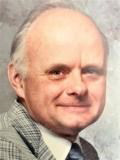In memoriam: Clark Bublitz
Clark Bublitz, a metabolic enzymologist and a member of the American Society for Biochemistry and Molecular Biology since 1963, died Feb. 23. He was 94.

Born Dec. 8, 1927, in Merrill, Wisconsin, he was the son of Clark and Florence Bublitz. He attended the Pillsbury Military Academy in Owatonna, Minnesota, then joined the Army near the end of World War II and was stationed in Rome.
After the war, Bublitz earned a Ph.D. in biochemistry from the University of Chicago, and then he spent a year as a postdoctoral fellow at the Max Plank Institute in Germany where he worked with Feodor Lynen, who later shared the 1964 Nobel Prize in physiology or medicine.
Bublitz joined the faculty at the Johns Hopkins School of Medicine as an assistant professor. While at Hopkins, he met Deborah Keirstead, then a medical student. They were married in 1958. Bublitz spent a year at St. Louis University in Missouri before moving to the University of Colorado Medical Center in Denver, where he remained until his retirement.
Bublitz studied enzymes involved in metabolism in the rat liver, beginning in the 1950s with enzymes that phosphorylate glycerol. He later focused on L-gulonate, a six-carbon metabolite that is an important intermediate between glucose and the pentose phosphate pathway. In the 1960s, collaborating frequently with Albert Lehninger, he studied the conversion of gulonate into ascorbic acid, or vitamin C.
Bublitz was an enthusiastic hiker, tennis player and Green Bay Packers fan. He is survived by his wife, Deborah; five children, Nancy Dyer, Susan Schooleman, Philip Bublitz, Caroline Emsermann and Elizabeth Bublitz, and their spouses; and eight grandchildren.
Enjoy reading ASBMB Today?
Become a member to receive the print edition four times a year and the digital edition monthly.
Learn moreGet the latest from ASBMB Today
Enter your email address, and we’ll send you a weekly email with recent articles, interviews and more.
Latest in People
People highlights or most popular articles

Meet the editor-in-chief of ASBMB’s new journal, IBMB
Benjamin Garcia will head ASBMB’s new journal, Insights in Biochemistry and Molecular Biology, which will launch in early 2026.

Exploring the link between lipids and longevity
Meng Wang will present her work on metabolism and aging at the ASBMB Annual Meeting, March 7-10, just outside of Washington, D.C.

Defining a ‘crucial gatekeeper’ of lipid metabolism
George Carman receives the Herbert Tabor Research Award at the ASBMB Annual Meeting, March 7–10, just outside of Washington, D.C.

Nuñez receives Vallee Scholar Award
He will receive $400,000 to support his research.

Mydy named Purdue assistant professor
Her lab will focus on protein structure and function, enzyme mechanisms and plant natural product biosynthesis, working to characterize and engineer plant natural products for therapeutic and agricultural applications.

In memoriam: Michael J. Chamberlin
He discovered RNA polymerase and was an ASBMB member for nearly 60 years.
